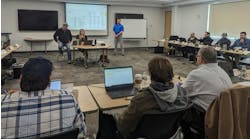WASHINGTON, D.C.—At a recent plumbing industry meeting, the issue of workforce development came front and center, and yet merely 50% of those in attendance felt that the topic was a pressing issue. How could this be, I thought? Michael Copp, Executive Vice President, Plumbing-Heating-Cooling Contractors-National Assn. (PHCC) was also in attendance and voiced his opinion on the importance of workforce development.
When I returned home, Michael and I chatted at length about the topic and I recently caught up with him to get some of his thoughts on the issue.
CONTRACTOR: Do you think that workforce development issue is at crisis mode nationally?
COPP: Workforce challenges are not the same across the country and across industry sectors. In general, though, according to the Bureau of Labor Statistics (BLS), the economy will resume at a growth rate of 2.5% and construction starts will remain virtually unchanged ($808 billion) in 2019. The number of plumbing and HVAC companies will grow by 1.8% and 2.6%, respectively. For every four jobs that are vacated, the industry is only filling one. Also, according to the BLS, there were 480,600 plumbing jobs back in 2016, with positive growth expected for the next 10 years. “Employment of plumbers, pipefitters, and steamfitters is projected to grow 16% from 2016 to 2026, much faster than the average for all occupations.”
The employment of HVAC technicians is expected to grow by 15% during the same 10-year period, with the number of jobs back in 2016 at 332,900. The U.S. jobless rate fell below 4% since 2000—with job openings exceeding 6.6 million in March, according to a May 24, 2018 article written by Jennifer Levitz in the Wall Street Journal, “Plumbing Firms, Drained by Labor Shortage, Tap Perks.”
By the end of 2020, more than 50% of businesses entering the construction industry will be minority- or female-owned. Exacerbating the problem is the strict immigration policies that will continue to impact the availability of construction workers.
CONTRACTOR: What do you think is the crux of the skilled trades problem?
COPP: While the narrative is slowly changing from “College Readiness” to “Career Readiness,” we have to overcome what has been a cultural norm in which “For two or three generations, the focus has been to go to college, get a degree and in doing so you will ensure a brighter future with more access to employment,” (Joshua Wright, America's Skilled Trades Dilemma: Shortages Loom As Most-In-Demand Group Of Workers Ages, 2013).
However, according to the Association for Career & Technical Education (ACTE), 85% of the jobs in America do not require a college degree, but do require post-high school training. Tangentially, according to a study from the Brookings Institution the “volume and frequency of student loans increased significantly” from 2002 to 2012, with loans spiking 77%. The price tag for attending even an in-state, public four-year college leapt by nearly 32% in the same period.” (Leah McGrath Goodman, Millennial College Graduates: Young, Educated, Jobless, 2015).
Anthony Carnevale, a director and research professor for Georgetown University’s Center on Education and the Workforce notes that “we have a debate raging in this country right now over whether universities are supposed to teach for enlightenment or to prepare students for the job market. You still see presidents at some very prestigious universities arguing for the former, not the latter.” (Goodman, 2015)
Much of these realities are hard to reconcile given the dichotomy between high unemployment rate of college graduates, climbing tuition rates, the high number of available skilled-trade jobs that go unfilled and the desperate need to fix a decaying infrastructure that threatens the health and safety of our citizens.
TV Personality Mike Rowe expressed in an interview with TheBlaze TV’s Andrew Wilkow that “We’re lending money we don’t have, to kids who will never be able to pay it back, for jobs that no longer exist … That’s crazy, right? That’s what we’ve been doing for the last 40 years.” (Mike Rowe on How Many Are Following the ‘Worst Advice in the History of the World, 2015)
We need a movement: a cultural shift in which parents, guidance counselors and others do not view vocational skilled-trades education/apprenticeships as a second option to going to college. With the right policy reforms and resetting national priorities, skilled- trade education can lead to additional education and career advancement.
The DOL reported on September 21, 2016 that “Today, 91% of apprentices remain employed after completing their programs, with average annual starting wages above $50,000. The return on investment for employers is substantial, as studies indicate that for every dollar spent on apprenticeship, employers receive average of $1.47 return in increased productivity.”
CONTRACTOR: Beyond the great salary and living one can make, no student debt, job placement and paid apprenticeships, what are the major attractions to the trades?
COPP: Beyond what you have noted, younger generations are very aware of and value their social responsibility to society. For example, those interested in the industry will appreciate—as the BLS indicates—that the industry growth will grow with “rising demand for energy-efficient products will create growth for the industry.”
CONTRACTOR: I’ve noticed that some manufacturers are getting involved with training, scholarships, but is this enough or a good start?
COPP: I hear that manufacturers are not finding fully “employable” candidates with the skills and knowledge employers need. Hence, there has been a growing trend of manufacturers developing training out of necessity that develops problem-solving and critical thinking skills, teambuilding and communication skills, math skills and critical reading skills, just to name a few. PHCC benefits from manufacturing participation as exemplified by PHCC’s corporate partners: Bradford White Corporation, Federated Insurance, International Code Council, InSinkErator, Kohler Co., Viega and Milwaukee Tool; all who financially support PHCC apprenticeship training and PHCC professional development.
CONTRACTOR: Do you feel that the industry needs to come together as a whole to combat this problem?
COPP: As I have written in the past, “There exists a national catastrophe that requires nothing short of a national cultural pivot: something akin to Theodore Roosevelt’s “Square Deal” or Franklin Delano Roosevelt’s “New Deal” in which a national crisis required a transformational shift in national priorities to protect the health and safety of the American people.
As was true in 1910 and in 1933, we now need a national movement to attract and educate enough skilled tradespeople to fix the declining economic health of the construction trades industry and crumbling infrastructure. We need to get back to a time when “youth in olden days achieved the status of craft workers, they became important members of society.” (Washington State Dept. of Labor & Industries)
We need to reestablish vocational education that was dismantled in much of the country. We need to achieve greater diversity within the skilled-trades industries to include more women, minorities and at-risk youths: all seeking that same level of importance and respect applied to their contribution to society.
CONTRACTOR: How can we tackle this issue with more fervor?
COPP: Several ideas that might help mitigate the workforce shortage include:
• Consider rehiring retired employees as part-time professionals. They will likely appreciate the few extra dollars and could fill a vital role in sharing institutional knowledge with younger staff as well as becoming mentors for them.
• Emphasize recruiting of minorities, at-risk youths, military veterans and women into the industry. There are a number of government programs designed to assist with this effort.
• Explore ways to become the “Employer of Choice” by exploring perks not offered by other competitors. Levitz (2018) notes that contractors are offering signing bonuses (and signing day celebrations), hosting company-sponsored classes outside of the p-h-c PHCC’s membership should reflect the demographics of the current available workforce if it wants to recruit and retain members. That requires that PHCC attract a diverse membership through efforts like:
—Offering courses in various languages.
—Actively recruiting women and minorities.
—Creating young professional groups that are diverse and discuss opportunities and challenges that are important to them.
—Developing a local summit to talk about strategies for reaching out and connecting with a broader group of potential members in each state.
—Recruiting out-of-state candidates and paying moving costs, providing special event tickets, offering family trips, sponsoring gym memberships, and keeping trucks equipped with latest technology that they can drive home.
• PHCC met with Jan Bray with Bray Strategies to talk about workforce development and efforts of the National Association of Workforce Boards (NAWB). According to its 2016 Annual Report, NAWB “represents over 500 business-led Workforce Development Boards and the 12,000 business and public sector volunteers who serve on those boards. NAWB helped state and local workforce boards leverage over $4 billion in annual federal funding to support local and regional workforce training initiatives. Its members provided assistance to more than 13 million people in 2015, placing 7.8 million people in jobs.”
I had an opportunity to speak on a panel about workforce challenges within our industry at NAWB’s Annual Forum—during which “[1,500] workforce development professionals and leaders in business, government, labor, and education gathered to talk about the current state of our nation’s workforce system.” However, it occurred to me that many of our members are unaware of the existence of local workforce boards as a source of candidates.
Local workforce boards place candidates into jobs by identifying candidates for apprenticeships and provide federal funding to place and train candidates. P-h-c contractors can access local workforce boards for candidate placement who come with funding for training already approved. Local and state PHCC chapters that offer apprenticeship programs can apply to become eligible training providers. They can promote and facilitate the connection between their contractors and local workforce boards.
CONTRACTOR: How does the PHCC assist in this mission?
COPP: PHCC National’s workforce goal is to help reduce workforce shortages within the industry through PHCC’s leadership and education efforts that include:
• Increasing the number and effectiveness of PHCC workforce recruitment resources.
• Increasing the utilization of workforce recruitment resources.
• Increasing PHCC’s role in raising awareness of job opportunities.
• Facilitating getting curriculum into high schools
Since 2016, PHCC National has:
• PHCC hosted a Capitol Hill Roundtable to discuss workforce shortage issues. With an expected shortage of more than 138,000 employees by 2022, the industry faces a “workforce time bomb,” said roundtable facilitator Tom Applegate, executive director of the Ohio Association of Career-Technical Superintendents and a member of the PHCC Educational Foundation Board of Directors.
To raise awareness of the issue, a panel of PHCC contractors from across the country shared the proactive solutions they have implemented to fill some of the many jobs and career opportunities available in the industry. It was great to hear contractors talking about success they are having in recruiting new employees with home-grown programs they developed and refined over time. This event gave our members a platform upon which they could express their continued need for skilled and career-minded employees—with PHCC leading the conversation.
In summary, several key takeaways included:
1. Not only is this a workforce issue, but an economic issue
2. Innovative ways that contractors are addressing the shortage locally are replicable and scalable like the Ride and Decide Program in TX, CA and TN
3. Legislators can assist with funding to help local contractors address the shortage:
a) Public Service Announcement
b) Grants to build toolkits to help local and state PHCC chapters work with educators to create and awareness of good jobs, good careers
c) Additional funding for the Carl D Perkins Career and Technical Education Act to increase a school’s ability to meet the growing needs of the plumbing, heating and cooling industry.
• PHCC Met with White House officials and Congressional leaders to discuss infrastructure and workforce challenges.
• PHCC continues to advocate for reauthorization of the Carl D. Perkins Act. It collaborates with other organizations like the NAWB, coalition and alliance trade associations, Congress and the White House to promote the need for employees and funding for trades training and apprenticeship programs.
• Adding to its toolbox of targeted solutions to address the critical worker shortage facing the plumbing-heating-cooling industry, the PHCC Educational Foundation has developed a HVAC & Plumbing Pre-Apprenticeship Course, giving potential workers an opportunity to learn about the day-to-day aspects of the trades before beginning a longer-term apprentice program and eventual career. Available online, prospective apprentices can take the course at their convenience, using six thematically-focused modules that offer an introduction to the trades plus other important aspects of working in the industry, such as basic math skills, tools, safety, and construction drawings.
• In 2019, PHCC became an official partner for the Skilled Trades Coalition address the need to draw young people to learn skilled trades is especially acute in critical roles such as plumbers and others that require extensive training to achieve competence.
• PHCC signed the White House’s Pledge to America’s Workers in 2019 in which PHCC committed to training up to 75,000 apprentices over the next 5 years through our PHCC Educational Foundation and PHCC Chapter network utilizing its online plumbing and HVAC apprenticeship program.
• PHCC continues to update and offer workforce development tools and resources.
• We’re very proud of the involvement of the PHCC Educational Foundation, contractor volunteers and industry partners in the SkillsUSA National Leadership and Skills Contest in Louisville, Kentucky.




